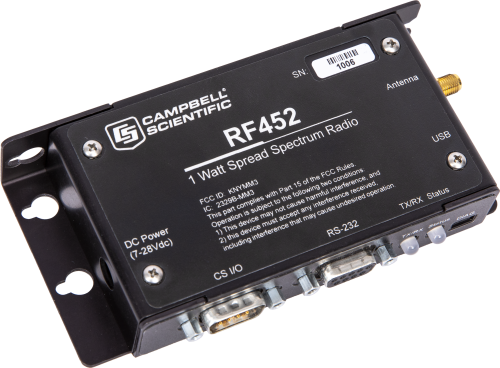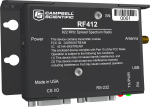
Overview
The RF452 is a powerful 900 MHz serial radio that is well suited for wireless networking with PakBus data loggers that are located miles apart. The RF452 is a 902 to 928 MHz frequency-hopping spread-spectrum radio. The radio features high noise immunity, fast serial data transfer speeds, and the maximum transmit power allowed by the FCC in an effort to provide reliable, hassle-free operation.
Constructing a network using RF452 radios is a simple, easy-to-do configuration process. To construct a network, connect one radio to a PC and configure it as the gateway radio. Then connect a second radio to a data logger. The link can be treated as a high-speed, multi-drop serial connection.
Read MoreBenefits and Features
- Does not require individual operational license in the United States, Canada, New Zealand, and Australia
- Long-distance, high-speed, serial communication with battery-operated stations
- Each radio capable of performing gateway, remote, or repeater role
- Remote diagnostics and setup possible with diagnostics cable and software
- Compatible with existing RF450, RF451, and FreeWave FGR radio networks
Images




Detailed Description
The RF452 is a frequency-hopping spread-spectrum radio, capable of operating between 902 and 928 MHz and transmitting up to 1 Watt (30 dBm). The specific frequencies used may be selected when operating outside the US and Canada to meet local regulations. Additionally, the RF power output may be adjusted to as low as 10 mW via software.
Typical communication distances are greater than four miles with up to 60 miles achievable under ideal conditions. Extended communication distances are possible using repeaters.
The operating frequency band of this radio modem may be shared with other non-licensed services such as cordless telephones and with licensed services including emergency broadcast and air-traffic control.
The RF452 consists of a radio module manufactured by FreeWave Technologies and a Campbell Scientific interface board. It reduces susceptibility to RF interference from other spread-spectrum devices by providing user-selectable frequency-hopping patterns. Spread-spectrum radios spread the normally narrowband information signal over a relatively wide band of frequencies. This process allows communications to be more immune to noise and other interference.
RF452 radios, as well as all FCC Part 15 devices, are not allowed to cause harmful interference to licensed radio communications and must accept any interference that they receive. Most Campbell Scientific users operate in open or remote locations where interference is unlikely. If there is a problem, interference can be reduced using methods such as moving the device, reorienting, using a different type of antenna, or adding RF shielding.
Powering the Radio
At least two radios are required to create a link. The radio may be powered through the DC barrel connector or via a CS I/O connection. When AC power is available, the 15966 wall charger is commonly used. At remote sites, the RF452 typically is powered through the CS I/O or the 14291 field cable.
Antennas
Campbell Scientific offers a variety of antennas for this radio. The 14204 is a 0 dBd, 1/2 wave omnidirectional whip antenna that connects directly to the radio (no cable required) and can transmit short distances (up to 1 mile). The 15970 dipole antenna includes adhesive for window or wall mounting and a cable for connecting to the radio.
Our higher gain 14221 omnidirectional and 14205 Yagi antennas require a cable to connect them to the radio. The 31314 surge protector is available for radios susceptible to lightning or electrostatic buildup or when the cable length needs to be longer than 3 m (10 ft), as measured between the transceiver and the antenna.
Compatibility
Note: The following shows notable compatibility information. It is not a comprehensive list of all compatible or incompatible products.
Data Loggers
| Product | Compatible | Note |
|---|---|---|
| CR1000 (retired) | ||
| CR1000X (retired) | ||
| CR10X (retired) | -PB option | |
| CR200X (retired) | ||
| CR206X (retired) | Connects via RS-232; disable internal 900 MHz radio | |
| CR211X (retired) | Connects via RS-232; disable internal 900 MHz radio. | |
| CR216X (retired) | ||
| CR23X (retired) | -PB option | |
| CR295X (retired) | ||
| CR300 (retired) | Connects via RS-232; use a 18663 null modem cable. | |
| CR3000 (retired) | ||
| CR350 | Connects via RS-232; use a 18663 null modem cable. | |
| CR510 (retired) | -PB option | |
| CR6 | To integrate the CR6 with the RF452, order the CR6-RF452 option on the CR6 product page. | |
| CR800 (retired) | ||
| CR850 (retired) |
Additional Compatibility Information
Data Logger Considerations
For non-PakBus data loggers, there is typically only one data logger on the network, as they cannot be uniquely addressed by LoggerNet. The RF452 does not support Modem Enable devices over CS I/O. An RF452 may be connected to a mixed-array data logger (for example, CR10, CR10X) by using an SC932A or SC105 between the data logger's CS I/O port and the RF452's RS-232 port.
Spread-Spectrum Radio Considerations
The RF452 is compatible with existing RF450, RF451, and FreeWave FGR radio networks. The RF452 is not compatible with other spread-spectrum radios (RF407, etc.).
Specifications
| Radio Type | Frequency Hopping Spread Spectrum (FHSS) |
| Frequency | 902 to 928 MHz |
| Country Used In | US, Canada, New Zealand, Australia |
| Power Output | 10 to 1,000 mW (user-selectable) |
| Transmission Distance |
|
| Modulation | 2 level GFSK |
| RF Data Rate | 115.2 or 153.6 kbps (selectable speeds) |
| Occupied Bandwidth | 142 kHz (applicable to FCC ID KNYMM3) |
| Hopping Patterns | 15 per band, 105 total (user-selectable) |
| Hopping Channels | 50 to 110 (user-selectable) applicable to FCC ID KNYMM3 |
| Channel Spacing | 230.4 kHz |
| Frequency Zones | 16 |
| Receiver Sensitivity |
|
| IF Selectivity | 40 dB (at fc ± 230 kHz) |
| Receiver Selectivity | 50 dB (at 896 MHz, 935 MHz) |
| Error Detection | 32-bit CRC (retransmit on error) |
| Data Encryption | Proprietary spread-spectrum technology |
| Link Throughput | 115.2 kbps (maximum) |
| RF Connector | Reverse Polarity SMA (RPSMA) jack (external antenna required) |
| CS I/O | DB9 M, SDC 7/8/10/11 device |
| RS-232 | DB9 F, DCE |
| Operating Temperature Range | -40° to +85°C |
| Relative Humidity | 0 to 95% RH (non-condensing) |
| Compliance Information |
|
| Average Current Drain (@ 12 Vdc) |
|
| Communication Ports |
|
| Service Requirements | Shares frequency with other devices. Must not cause harmful interference to licensed radios. Requires line-of-sight. |
| Dimensions | 13.61 x 2.74 x 7.01 cm (5.36 x 1.08 x 2.76 in.) |
| Weight | 0.18 kg (0.4 lb) |
Power |
|
| Input Voltage | 7 to 28 Vdc |
| Powered Over | CS I/O or barrel plug |
| Connector | Barrel plug, center positive 12 V (used to connect the 14291 Field Power Cable or 15966 AC adapter) |
USB |
|
| -NOTE- | Used for connection to computer for network communications or device configuration. Does not supply enough power for normal operation; RF452 must be powered through DC barrel plug or CS I/O. |
| Type | USB standard B (device only) |
Documents
Brochures
Technical Papers
Compliance
Downloads
Device Configuration Utility v.2.33 (49.6 MB) 07-07-2025
A software utility used to download operating systems and set up Campbell Scientific hardware. Also will update PakBus Graph and the Network Planner if they have been installed previously by another Campbell Scientific software package.
Supported Operating Systems:
Windows 11 or 10 (Both 32 and 64 bit)
RF45x Operating System v.3 (429 KB) 06-16-2023
Current RF451 / RF452 operating system. The Device Configuration Utility is used to update the firmware.
Articles and Press Releases
Blog Articles
-
Tips to Troubleshoot and Optimize Large RF Networks: Part 3

01-02-2024 Author: Nathanael Wright -
Tips to Troubleshoot and Optimize Large RF Networks: Part 2

12-20-2023 Author: Nathanael Wright -
Tips to Troubleshoot and Optimize Large RF Networks: Part 1

10-31-2023 Author: Nathanael Wright
Privacy Policy Update
We've updated our privacy policy. Learn More
Cookie Consent
Update your cookie preferences. Update Cookie Preferences


